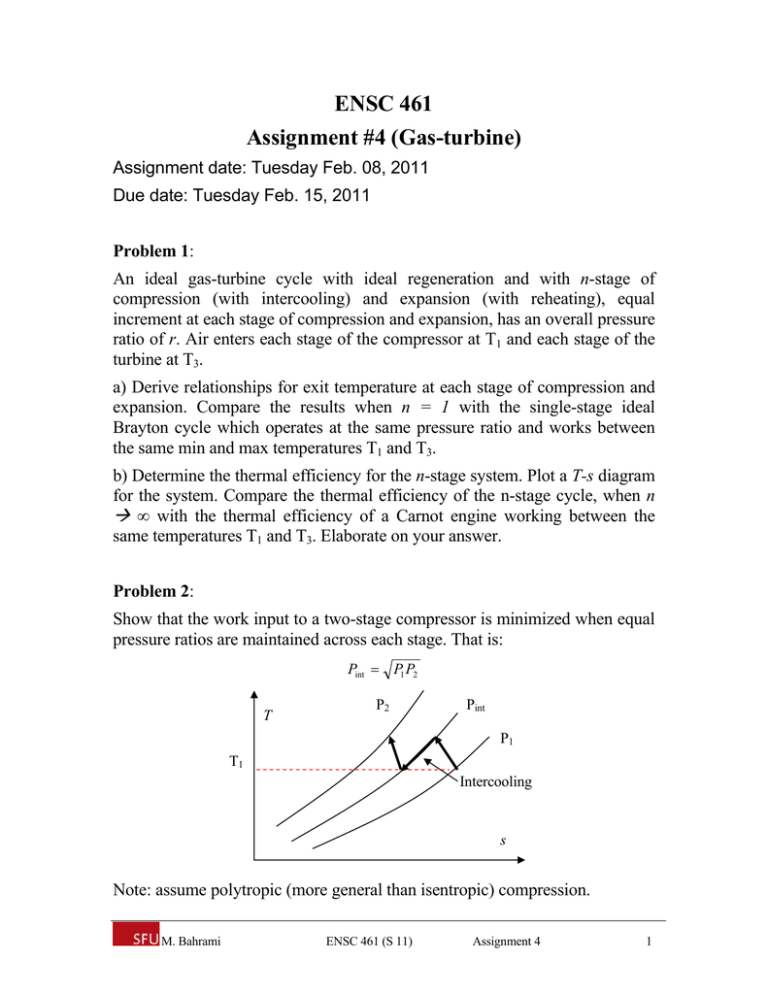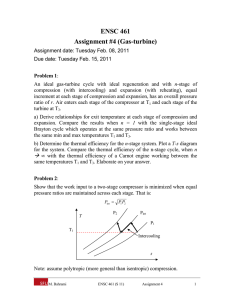ENSC 461 Assignment #4 (Gas-turbine)
advertisement

ENSC 461 Assignment #4 (Gas-turbine) Assignment date: Tuesday Feb. 08, 2011 Due date: Tuesday Feb. 15, 2011 Problem 1: An ideal gas-turbine cycle with ideal regeneration and with n-stage of compression (with intercooling) and expansion (with reheating), equal increment at each stage of compression and expansion, has an overall pressure ratio of r. Air enters each stage of the compressor at T1 and each stage of the turbine at T3. a) Derive relationships for exit temperature at each stage of compression and expansion. Compare the results when n = 1 with the single-stage ideal Brayton cycle which operates at the same pressure ratio and works between the same min and max temperatures T1 and T3. b) Determine the thermal efficiency for the n-stage system. Plot a T-s diagram for the system. Compare the thermal efficiency of the n-stage cycle, when n ∞ with the thermal efficiency of a Carnot engine working between the same temperatures T1 and T3. Elaborate on your answer. Problem 2: Show that the work input to a two-stage compressor is minimized when equal pressure ratios are maintained across each stage. That is: Pint P1 P2 T P2 Pint P1 T1 Intercooling s Note: assume polytropic (more general than isentropic) compression. M. Bahrami ENSC 461 (S 11) Assignment 4 1 Solution, Problem 1: QReheat 3 T … QH QRegenerator QL … QIntercooler 1 s Compression: Since pressure increments are identical, one can write: Pi,c = P1 + (i-1) (P2 – P1) / n 1 < i < n+1 (1) where P1 and P2 are the first and last stage pressure of compression, and Pi,c is the pressure at i-th stage of compression. Equation (1) can be re-arranged as Pi,c = P1 [1 + (i-1) (r-1)] where r = P2 / P1. Since the compression process is isentropic, one can write: Ti ,c Ti 1,c Pi ,c Pi 1,c k 1 / k The inlet temperature to each compression stage is T1 = Ti-1; k 1 / k i 1 1 n r 1 (2) Ti ,c T1 i 2 1 r 1 n Substituting n = 1 (i = 2) yields; T2 = T1 r (k-1)/k Expansion: Following the same method, for multi-turbine with reheat, we can write: Pi,t = P2 + (i-1) (P2 – P1) / n 1 < i < n+1 (3) M. Bahrami ENSC 461 (S 11) Assignment 4 2 or, Pi,t = P2 [1 + (i-1) (1-1/r)] Since isentropic expansion occurs in turbines, we have Ti ,t Ti 1,t Pi ,c Pi 1,c k 1 / k which can be written as: k 1 / k i 1 1 1 n 1 r (4) Ti ,t T3 i 2 1 1 n 1 r Because of reheating Ti-1,t = T3 for all stages of turbine. For example for a single-stage system, Eq. (4) yields: T4 = T3 (1/r) (k-1)/k It should be noted that at the limit when n ∞, Eqs. (2) and (4) become: k 1 / k i 1 1 r 1 n limit n Ti ,c limit n T1 T1 (5) 1 i 2 r 1 n k 1 / k i 1 1 1 n 1 r limit n Ti ,t limit n T3 T3 (6) i 2 1 1 n 1 r Equations (5) and (6) show that if the number of compression (with intercooler) and expansion (with reheat) is increased, the ideal cycle of expansion and compression processes become isothermal, see Fig. below. T QReheat 3 T3 4 QH QL T1 2 1 QIntercooler s Therefore, input heat becomes: M. Bahrami ENSC 461 (S 11) Assignment 4 3 qin = q reheat Note that at the limit n ∞, qH = qL 0. Also T3 = T4 and T1 = T2. Assuming ideal gas and standard-cold-assumption: qin = T3 (s4 – s3) s4 – s3 = - R ln (P4 / P3) = - R ln (1/r) = R ln (r) qin = R T3 ln (r) (7) The heat-rejection from the system is: qout = q intercooling Assuming ideal gas and standard-cold-assumption: qout = T1 (s1 – s2) s1 – s2 = - R ln (P1 / P2) = - R ln (1/r) = R ln (r) qin = R T1 ln (r) (8) The thermal efficiency for the cycle becomes: n stage , Brayton 1 q out RT ln r T 1 1 1 1 q in RT3 ln r T3 which is the Carnot cycle thermal efficiency. In fact the T-s diagram ideal gas-turbine with regenerator and n-stage compression and expansion with intercooler and reheat becomes the T-s diagram of Ericson cycle working between the same … Solution, Problem 2: The total work input for a two-stage compressor is the sum of the work inputs for each stage of compression: wcomp ,in wcomp1,in wcomp 2,in nRT1 Pint n 1 P1 n 1 / n nRT P n 1 / n 1 2 1 1 n 1 Pint The only variable in this equation is Pint. The Pint that minimizes the total work is determined by differentiating this expression with respect to Pint and setting the resulting expression equal to zero. It yields: Pint P1 P2 M. Bahrami ENSC 461 (S 11) Assignment 4 4




